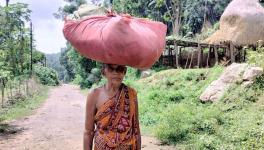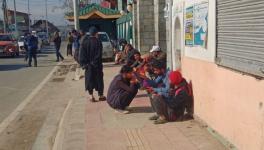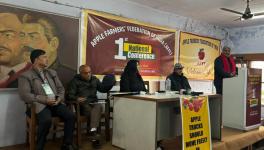Kashmir: Women in the Woods--Why Firewood is Ultimate Favourite of Rural Households in Winter
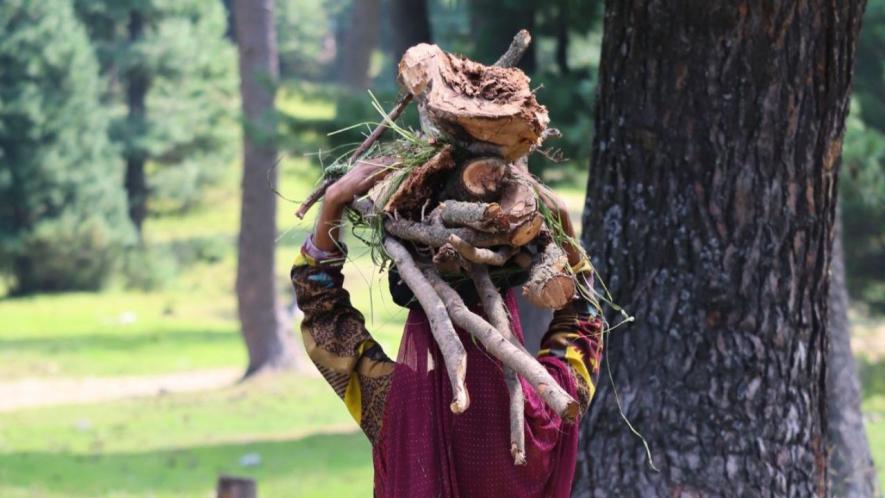
A woman carrying firewood from the forest (Photo - Khursheed Ahmad Shah, 101Reporters)
Kupwara, Jammu and Kashmir: “I prefer zyun [wood] over gas,” states Saja Begum (43) of Rajwar in Kupwara of Jammu and Kashmir. “If we rely on LPG cylinders for both cooking and room heating, they will last only for eight days,” she adds.
The preference for firewood and bukharis (traditional stoves) running on it is not for cooking alone, but also for warmth during chillai kalan, the state’s intense cold spell lasting for 40 days from December 21 to January 29. Throughout the winter, bukharis operate from 7 am to 10 pm daily. Even when not cooking, villagers keep it lit for heating purposes.
In the villages of Hamam, Markoot, Pazalpora, Dazana, Pakhwari, Hunoora, Nowpora, Doniwari, Tangmulla, Chatoosa, Khahmoha, Braman, Lariangan, Judinambal and Naribal in Rohama block of Baramulla, approximately 65% of the population depends on firewood, either for heating or cooking, despite having LPG connections. In far-flung areas, LPG cylinders are not an option during winters as these areas remain cut-off from main towns. Though exhausting to collect, firewood is a free alternative.
Typically, firewood collection to tide over chillai kalan ends by November. The village women gather one gidh, a bundle of a dozen deadwood or damaged branches, at a time and walk roughly four km up and down the forest to finish the task.
The irony is that despite having LPG cylinders, women think it is their responsibility to save every penny possible by depending mostly on firewood. They see firewood collection as their duty — a duty that comes with difficulties.
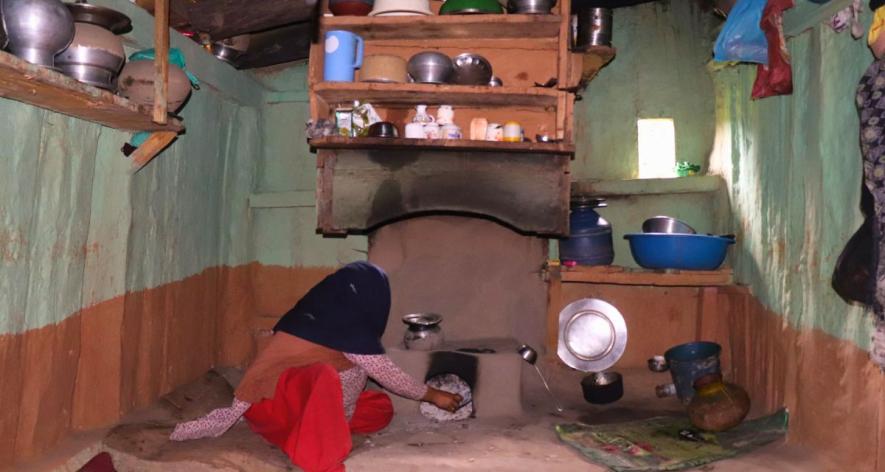
A woman using a traditional stove in the kitchen (Photo - Umer Farooq)
Rural women are often vulnerable to musculoskeletal injuries and chronic back pain. They are more prone to neck, spinal code and knee issues. "It is important to use protective gear, wear proper footwear and adopt correct lifting practices to prevent injuries and to promote better overall health," suggests Dr Nisar Ahmad Shah, assistant professor, orthopaedics, Government Medical College, Handwara.
He has treated numerous women who sustained injuries, including thorn punctures that led to infections and cases of plantar fasciitis from prolonged standing or walking on hard surfaces with heavy loads. He has also helped patients recover from spinal issues, such as disc degeneration caused by improper lifting techniques.
Many women also suffer from nutritional deficiencies and fatigue. They consume rice, often thrice a day, due to their workload. Their primary source of protein a few years ago was milk. But now, only a few raise cows.
"Many rural women follow an unbalanced diet, which largely comprises rice, pulses and low-quality proteins, with an excessive reliance on carbohydrates. Additionally, they consume ample amounts of nun chai [traditional pink tea], which, due to its high tannin content, further impairs the absorption of essential proteins and vitamins," notes Dr Pakeeza Kauser, a government medical officer at Vodipora in Handwara.
She also highlights widespread issues such as nutritional anaemia, calcium and vitamin deficiencies, and hygiene-related conditions. "Poor hygiene is a major contributor to skin infections such as scabies here," she adds.
Restricted access, dwindling income
Shaneena Begum (47) hails from the Kupwara Kandi belt. On average, she collects one bundle of firewood each day from the nearby forest during the collection season (from April to November, except during monsoon season). When there is an extra collection, she sells it to locals or to bakers making nanwai (local bread).
“People come in carts to buy what they need. Though the income is modest, we earn about Rs 1,200 to 1,500 in winter,” says Muneera Begum (40). “Demand is especially high during winter and wedding seasons when firewood is needed for cooking wazan [wedding feast],” she adds.
However, the supply has been going down gradually since the 1980s, due to the restrictions on entering the forest. It became more pronounced after the abrogation of Article 370.
Dr Humaira Qadri, an environmentalist and associate professor at Government Boys Degree College, Baramulla, tells 101Reporters that conflicts between local communities and forest guards are on the rise, with sometimes women denied access to forest resources. “In Kashmir, the women who collect firewood are mostly rural and indigenous people from communities that have relied on forest resources for generations, particularly in the regions of Kupwara, Bandipora, Baramulla and Anantnag. However, their rights to these forests are ambiguous and unrecognised," she details.
"The Forest Rights Act, 2006, legally grants scheduled tribes and other traditional forest dwellers the right to access, use and manage forest resources sustainably. However, its implementation in Jammu and Kashmir has been delayed and remains inconsistent due to a lack of awareness and various other reasons,” she adds.
Defending the restrictions, Abdul Qayoom Sofi, Block Forest Officer, Jhelum Valley Forest Division, Baramulla, tells 101Reporters that the forest department had to take measures as women stomp on fresh saplings, effectively destroying them. “Moreover, flocks of livestock entering the forest can stop plant growth and regeneration.”
Touching on the issue of firewood shortage in the region, he notes, “When firewood is unavailable in the compartments, we try to intervene and prevent harm. Without this intervention, many women, frustrated by the scarcity of resources, take matters into their own hands and begin lopping off conifers. Unfortunately, this practice dries out the trees and causes them to die.”
Sofi highlights the importance of adhering to regulations under Section 26(1) of the Indian Forest Act, 1927, which aims at protecting the forest ecosystem. “The restrictions are strictly enforced for anyone carrying sharp tools," he adds.
According to Qadri, such restrictions have mainly affected low-income families. "A decade ago, the cost of one bundle of firewood ranged from Rs 30 to 50, but due to government restrictions and checkpoints, the availability is low. They cannot collect enough or make enough money by selling it, even though the price has gone up to Rs 100-120 in Baramulla, and Rs 150-180 in parts of Kupwara, such as Putushai Lolab,” she notes.
The forest department provides wood for Rs 750 per 100 kg for commercial purposes and Rs 335 for hammams (traditional steam bath) in religious places. These logs require additional labour for transportation and for breaking them down into usable small pieces. It also needs official documentation and approval, which takes months together.
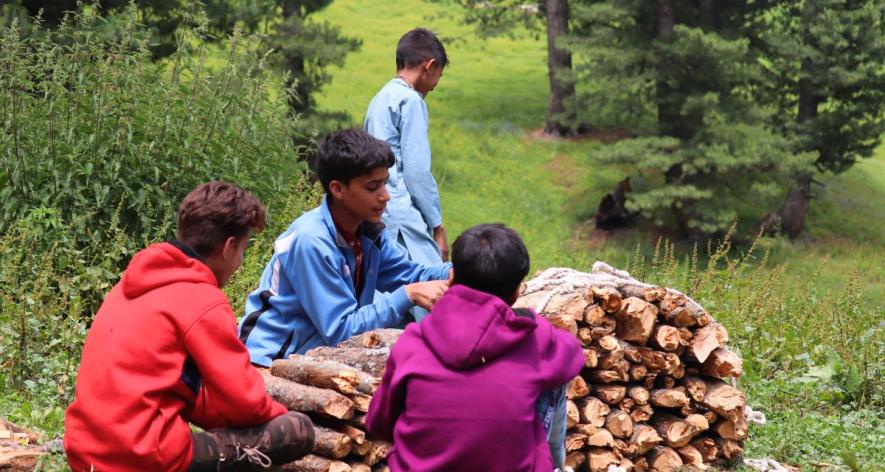
No chillai kalan period passes without wood (Photo - Umer Farooq).
"At present, we provide firewood only to mosques located in municipal or town areas. Even then, the department is not able to fulfil the exact demand of firewood... Only a limited quantity of conifer firewood is extracted and sold... If its commercialisation is allowed, it may put additional pressure on the forests, resulting in their depletion,” Tanveer Ahmad Malik, Block Forest Officer, Nowgam Mawer (Langate range), Kupwara, tells 101Reporters.
Though it is believed that women's firewood income is affected by the forest department's sale, Malik believes the real reason is the increasing use of byproducts of horticulture and agriculture instead of firewood in urban areas, and in some rural regions.
Conifers and energy efficiency
“The challenges faced by those collecting firewood vary greatly depending on the type of forest — whether it is a thorny or coniferous forest,” Sajad Ahmad Tantry, Block Forest Officer, Baderkali, Rajwar Forest Range.
In any local economy, broad-leaved varieties are important as they provide fuel, fodder for livestock, and manure for agriculture. However, human intervention has often replaced broad-leaved varieties with conifers, which have more commercial value and can be grown for export.
"In Kashmir, conifers such as deodar, fir, and pine have traditionally dominated temperate forests due to climate and altitude suitability, and also due to commercial timber value. The broad-leaved trees growing mostly in the lower altitudes include chinar, poplar and walnut, which are significant for the local economy by providing fuel, fodder and agricultural benefits. There are undeniable instances, particularly during afforestation drives of the Department of Social Forestry, when conifers are prioritised. Most restoration strategies favour conifers due to their fast growth and commercial utility, occasionally neglecting the ecological benefits of broad-leaved trees," explains Qadri.
According to her, broad-leaved species in lower altitudes have been impacted by urbanisation, developmental activities, timber smuggling and agricultural expansion over the years. "Very little effort has been taken to restore broad-leaved species," she notes.
Dry conifers are good for kindling a fire, but their energy efficiency is not as good as deciduous trees as they are less dense and have softer wood. "Conifers, with lower wood density and higher resin content, burn faster and typically generate 14-17 million BTUs per cord. In contrast, deciduous hardwoods are denser, burn slower and provide more sustained heat, delivering over 20 million BTUs per cord. So, deciduous trees are more efficient for long-term heating and cooking. The preservation of broad-leaved varieties in the lower altitudes can provide an all-time solution to the deforestation and encroachment of the conifer wealth," Qadri says.
In this context, Qadri advocates for energy-efficient chulas (stoves) that can produce more energy from the same amount of wood. “This can eventually reduce wood consumption, conserve natural resources and lessen environmental impacts.”
A gradual shift from overdependence on firewood is already noticed in places like Baramulla, where Turkish bukharis are becoming popular. As against the traditional tin-made bukharis, they are made of iron and can heat up the place better. In addition, they have compartments for cooking. Rather than firewood, biomass — including dried leaves and other tree remnants — can be used to run them.
Tariq Ahmad Chalkoo, a physics tutor at Government Boys Degree College and coordinator of the college's Bio Resource Innovative Cell, is analysing the potential of forest biomass. “Our innovation cell could process biomass [fallen branches, leaves, pinecones and other organic debris] into high-energy resources to make fire bricks that can conserve heat and produce electricity,” says Chalkoo, who is seeking an initial investment of Rs 1 crore to get the project off the ground.
Besides reducing dependence on forests locally, the firebricks can be exported, especially to Europe, where the demand for biomass-based products is high.
In the meantime, Kulsum Ahad, a scholar working on women empowerment and rural development in the Department of Social Work at the University of Kashmir, suggests creation of community-managed woodlots, formation of women self-help groups and provisions for better access to financial support and markets to improve the lives of women.
All these might take time, so for now, women take the rugged and muddy paths to the forest most of the days. “We start the day with a warm cup of nun chai, before proceeding to the woods. Every step must be taken carefully as there is a constant threat from bears and leopards. A wrong move on these hills could cost us our lives,” says Hafiza Begum (44) from Lolab in Kupwara.
Her friend Saleema Begum (42) describes how they ward off fear by constant chattering. “We just go on and on about village events, weddings, about syun [cuisine dishes], etc.” “Talking about our neighbours and village events takes our minds off the danger,” she says, finding comfort in the simple joys of community life.
Khursheed Ahmad Shah is a Jammu and Kashmir-based freelance journalist and a member of 101Reporters, a pan-India network of grassroots reporters.
Get the latest reports & analysis with people's perspective on Protests, movements & deep analytical videos, discussions of the current affairs in your Telegram app. Subscribe to NewsClick's Telegram channel & get Real-Time updates on stories, as they get published on our website.











